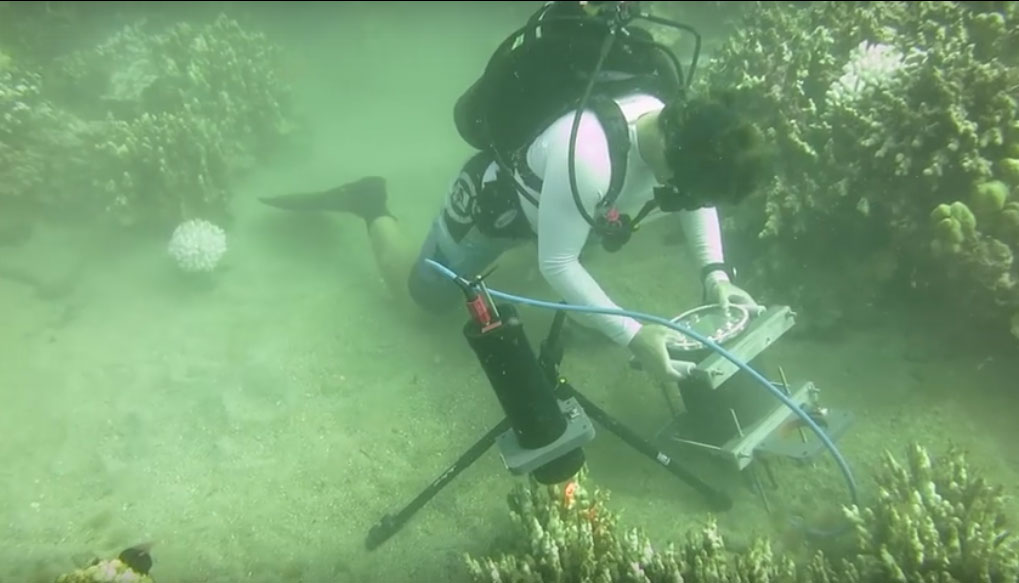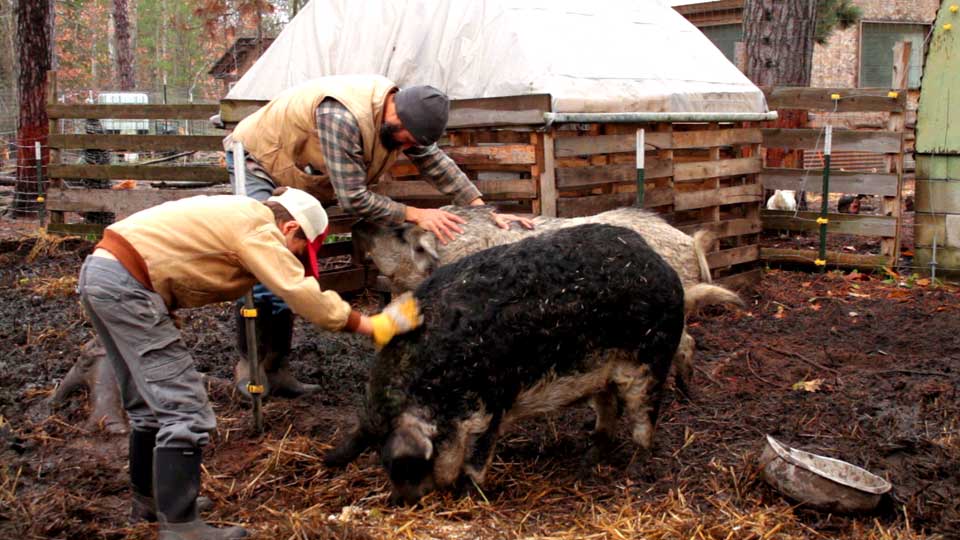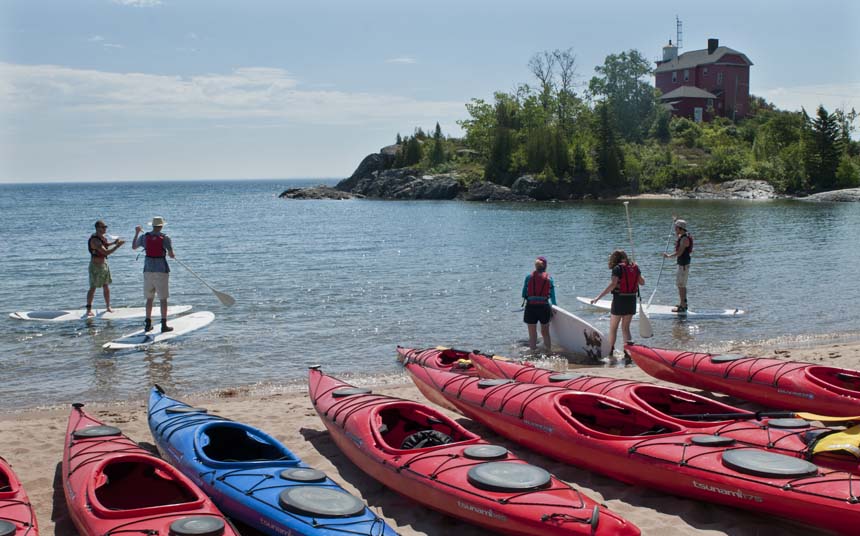We’re Holding Our Own: Tale From The SS Edmund Fitzgerald
written by: Ryan Stephens |

An underwater dive team explores the wreck of the SS Edmund Fitzgerald. (photo courtesy of the Great Lakes Shipwreck Historical Society)
Ghosts are forces of nature with unfinished business. They simply have something they need to accomplish before they move on. The water is dark as used motor oil and as cold as ice. Even through my six inch thick diving suit, Lake Superior chills me to the bone. I am deep diving today to install a new wheel on the helm of the legendary SS Edmund Fitzgerald to memorialize her crew. She sank 40 years ago. And to this day, no one knows why.
My name is John Hewlett. I make my living as an underwater welder. Exploring shipwrecks in the Great Lakes is a hobby of mine. I grew up watching freighters on the Detroit River while listening to Gordon Lightfoot sing “The Wreck of the Edmund Fitzgerald” on my transistor radio that was always tuned to AM 800 CKLW. When I heard the Mighty Fitz was getting a new wheel, I volunteered for this historic dive.
The Fitzgerald lies 17 miles off the coast of Whitefish Point, 530 feet down on the Canadian side of Lake Superior.
“We’re holding our own”, I faintly hear through my helmet radio. The static sound reminded me of my old radio from all those summers ago. Now is not the time to be having radio trouble.
“Hewlett to surface, over,” I radio back to my ship.
“We’re holding our own.” The voice sounded unfamiliar, not like the one from my ship.
“John Hewlett to surface, you copy?”
Even in the near darkness of Superior, I can see her now. Rust sits on her sides. Her nose is dug under the hard clay on Superior’s lake bed, the words Edmund Fitzgerald rusted around the edges. A slow chill rolls down my spine as I read the words. The top of the deck is mangled inward from the impact, rusty after 40 years.
Behind me a couple football fields away is the back end of The Fitz. She lies upside down, flat on the lake bottom. One can only imagine the brutal force that Gitche Gumee delivered upon this once mighty freighter to shear her in half.
While I cannot stop thinking about how she sank in two pieces, I must install the new wheel. I turn my attention to the job at hand. With the wheel in tow, I navigate through the wires and the bridge, making my way to the pilot house.
The pilot house door opens itself as if she was waiting for me to arrive. Standing in the darkness, I realize that no diver has been here before. I turn on my helmet lights.
The water inside the pilot house feels warm. Bath tub warm. I see something in the shadows of my flickering light. I turn my head around the corridor wall to look inside. My eyes widen, my heart beats faster. I see something move in the shadows. A dark figure. The silhouette of a man.
“McSorley? Captain McSorley?”
“Hewlett? John Hewlett?” the silhouette replies with a chuckle.
It’s the voice from my radio! As he steps towards me, I can see he has gray hair, slicked back in the fashion that captains back in the mid to late 1900’s used to wear. He is wearing a dark coat with dark trousers, the classic captain’s uniform.

The Great Lakes’ most famous shipwreck rests beneath the icy waters of Lake Superior. (photo courtesy of the Great Lakes Shipwreck Historical Society)
“Well, there is nothing wrong with my wheel, but I sure could use a few other things fixed – like both of my radars!” the captain says.
“I- I- I d- don’t understand,” I stutter. “I don’t understand.”
“What’s the matter, John? It seems as if you just saw a ghost!”
I feel the warmth of his spirit, yet I cannot move. I am frozen with fear as McSorley moves towards me. The pilot house door slams shut.
“Please sit down,” McSorley says as he points to a chair.
“My name is Captain Ernest M. McSorley. Welcome aboard the SS Edmund Fitzgerald, or what’s left of her.”
“H- h- how did you know my name?” I ask.
“We heard each other’s radio. I heard you calling to your ship, up above. You are diver John Hewlett,” he says.
He points to a rusted chair again, motioning for me to sit down, setting the memorial wheel aside.
“Like I was saying,” he says, “I have been waiting a long time for you to arrive. I have something to share with you.”

Edmund Fitzgerald in its watery grave. (photo courtesy of the Great Lakes Shipwreck Historical Society)
November 9th, 1975
“We loaded the Edmund Fitzgerald with 26,116 tons of Iron-Ore Taconite Pellets. She weighed at about 23,000 tons empty. Because she could carry more than her own weight, we proudly called her ‘Mighty Fitz.’ Later that afternoon, we set off on the last run of our season, from the small ore-port in which she was loaded, to a small steel mill at Zug Island, near Detroit, Michigan.
A few hours later, we met up with another ore freighter that was also heading towards the Soo Locks. The freighter was the Arthur M. Anderson, piloted by Jesse Bernie Cooper. We agreed to sail together, until we hit the Soo Locks, then we would depart from each other, and continue our journeys separately. We planned for a 15 mile lead on the Anderson for safety. It was smooth sailing on calm seas along Superior’s southern coastline. Just another November day, running another long-haul.”
November 10th, 1975
“We were sailing along Superior’s southern coastline the next day when the gales of November came early. Howling winds ripped through the air. Sleet blinded us. And 10 foot waves crashed over our decks. We and the Anderson took a terrible beating.
With our radios on, me and Captain Cooper heard that other Ore Freighters were setting anchor in Whitefish Bay. We were determined to make it to Whitefish Bay and drop anchor, protected from the storm.
The route along Superior’s Southern Coastline is very treacherous. My 44 years’ experience as a Great Lakes captain told me we needed to change course. We headed north into Canadian Waters to use Caribou Island as a shield from the storm. From there, we would head down to Whitefish Bay to hopefully reach safety.
As we approached Caribou Island, visibility was poor due to the blinding sleet and blowing snow. With little visibility, and nothing else to guide us, I had to rely on maps that were 100 years old to navigate through the Six-Fathom Shoal.”
“Excuse me, Captain, what is a shoal?” I interrupt.
“A shoal is an area of land where the water is very shallow. The water levels in a shoal are never quite the same depth from day to day. Some days the water is higher by a few feet. Some days the water levels are just lower. There is no exact measurement. This strikes problems for bigger ships like ours because we sit deeper in the water with heavy loads. The only problem is, us nor the Anderson, knew we were so close to Six-Fathom Shoal.”
“Did you hit bottom?” Hewlett interrupted again.
“Why did you ask me that?”
“Because there are theories from experts on how she sank, and that was one of them.”
“We took on some water, sure. But that is not why she sank. Just minutes after passing the Shoals, I radioed the Arthur M. Anderson to give her a damage report. ‘Anderson, this is the Fitzgerald,’ I said, ‘I have a fence rail down, two vents lost or damaged, and a list.’ Heading towards Whitefish Bay, the waves smacked our pilot house. Hurricane force winds ripped past the hull and her rails and her decks. She had taken a beating. We had taken a beating. But, we weren’t giving up without a fight. ‘Anderson,’ I said, ‘will you stay with me ‘till Whitefish?’
We ran ourselves into a big problem, about an hour later. With some 75 mile per hour hurricane force winds now, beating us, both of our radar antennae snapped off. We had no visibility, and we were now completely blind in one of the worst November Gale Storms in history. I radioed the Anderson again.
“Did water coming in from the loose hatch covers cause you to sink?” Hewlett asked.
“Is that one of the so called ‘expert theories’?”
“Actually, yes.”
“Well how many theories are there?”
“Rogue Waves.”
“A rogue wave?”
“Sure,” I joke,
“No, that is not what caused the largest freighter to ever sail the Great Lakes to sink.”
“The story of how the Fitzgerald sank has been an unsolved mystery for 40 years now,” Hewlett replies.
After an awkward moment of silence, Captain McSorley finishes his story.
“’How are you making out with your problems?’ First Mate Morgan Clark asked me.
‘We’re holding our own,’ I replied. We did not need any help. We thought we were almost at Whitefish Bay, we only had about 15 more miles left to go, until we reached safety. Just 15 more miles. We were so close.”
40 Years Later
“So McSorley,” I started, “how did the Fitzgerald go down that night? There are these three theories that experts have thought of, did you bottom out from the Six-Fathom Shoals? Did you have a structural failure and split in two at the surface?
Or were your 21 hatch covers loose letting water from the 30 foot rogue waves leak into your cargo hold?” I asked.
He looks at me, about ready to tell me.
“Right after I said ‘I was holding my own’, violent waves tilted the ship up on the front, the large load of Iron-Ore Taconite Pellets shifted to the rear, and another wave punched us up from the side, and in an instant after hearing the terrible, and sudden bends of our metal structure, the ship snapped in two, like a popsicle stick. Then another rough wave came down on top of the pilot house, covering the entire length of the ship, and sucked us under. That was the last thing I saw from my view out the pilot house. That was how we went down that night.”
“Thank you for telling me your story, Captain McSorley,” I say.
“I can’t even begin to tell you what that experience felt like, and what it means to me.”
“Superior they said never gives up her dead, and you will not give up the story,” he said.
“Yes, Captain,” I reply. He winks at me. I took notice of the rusted walls of the pilot house. How old and worn everything looked. The moss and other underwater things grew on the walls. Old. And worn. Lots of history.
“I best install this wheel before it gets too late. My crew will wonder what I have been doing.”
“Yes,” he says, “let me help you out there.”
He shuffles over, puts his hand on the other end of the wheel, and helps move it next to the other.
“Since you can’t return with a story to pass along, you may return with the original wheel. You can bring it back, where researchers can restore it, and bring it back to life, and keep it in a museum,” he says.
“Thank you,” I reply, “It will mean a lot to the families.”
We set it down, and walk out onto the bridge, outside of the pilot house, and we turn to face each other.
“So, John,” he starts.
“Yes Captain?”
“I need a favor,” he says. “Tell the families that I did everything I could to save the Fitzgerald. Their husbands and fathers, sons and brothers fought with me the whole way. She went down so fast that nobody suffered. The men died believing we’re holding our own.”
Afterword
Lake Superior is unforgiving. November is when most Great Lakes Freighters make their final runs for the season, like the Edmund Fitzgerald was. This is when Superior turns deadly.
My name is Ryan Stephens. Shortly after moving to Michigan, I became interested in the wreck of the Edmund Fitzgerald while doing a research project in 3rd grade. Six months of research later, and two visits to Whitefish Point, and the Great Lakes Shipwreck Museum and Whitefish Bay on Lake Superior, I finished my project, titled “We’re Holding Our Own”.
The Fitzgerald’s story is more memorable than other shipwrecks because of the mysteriousness. It is very unusual for a captain with 44 years of experience to say “We’re holding our own”, and then vanish without a trace. There were three theories that experts thought of:
- Loose hatch covers.
- Bottoming out on the Six-Fathom Shoals.
- Splitting in two at the surface from a rogue wave.
The legend of the Edmund Fitzgerald will always be a Michigan legend that no one will ever forget. I am still very much interested in the Edmund Fitzgerald, I decided to write this story about a fictional diver that dives down on the 40th anniversary, searching for an answer to how the Mighty Fitz sank that fateful night.














You must be logged in to post a comment Login